Summer 2020 loss of Arctic ice shelves
Milne Ice Shelf 2020
CALVING EVENT
The northern portion of the Milne Ice Shelf calved between July 30, 2020 and July 31, 2020. The ice shelf was reduced from 187 km2 to 106 km2 and a large ice island drifted north into the Arctic Ocean. This ice island broke into two parts by August 3, 2020 — the larger one was 55 km2 (~10 x 5.5 km) and the smaller one was 24 km2 (~5 x 5 km). Due to the presence of pre-existing fractures in the remaining Milne Ice Shelf, there is a potential for further destabilization.
This webpage contains satellite imagery of this event, provides a brief background on Canadian Arctic ice shelves and their decline and reveals a unique benthic ecosystem that was recently discovered within the Milne Ice Shelf.

Before Breakup. A true colour Sentinel-2 image (ESA) of the Milne Ice Shelf before it broke up at the end of July 2020. The ice shelf extent is in red and the coastline is in yellow. Map courtesy Yulia Antropova.

After breakup. A true colour Sentinel-2 image (ESA) of the Milne Ice Shelf after it broke up at the end of July 2020. The ice shelf extent is in red and the coastline is in yellow. Map courtesy Yulia Antropova.
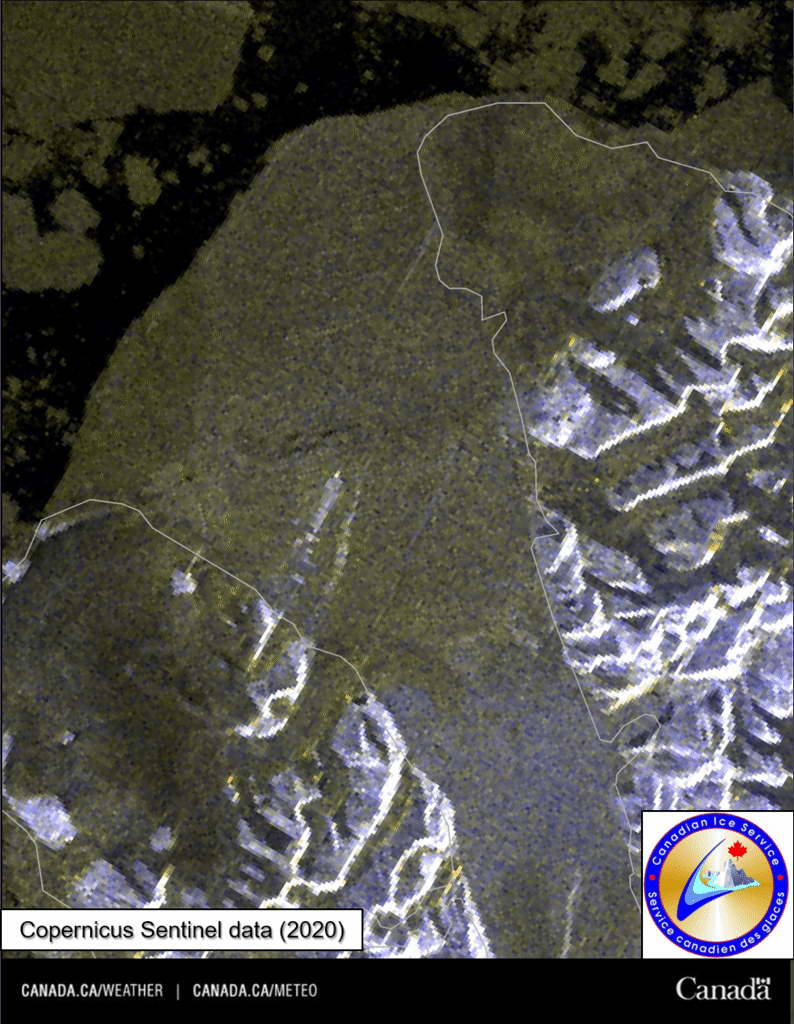
Radar (Sentinel-1) images of the Milne Ice Shelf breakup at the end of July 2020. This event was discovered by Dr. Adrienne White at the Canadian Ice Service. Courtesy of Dr. Adrienne White (Canadian Ice Service). Click here for more.
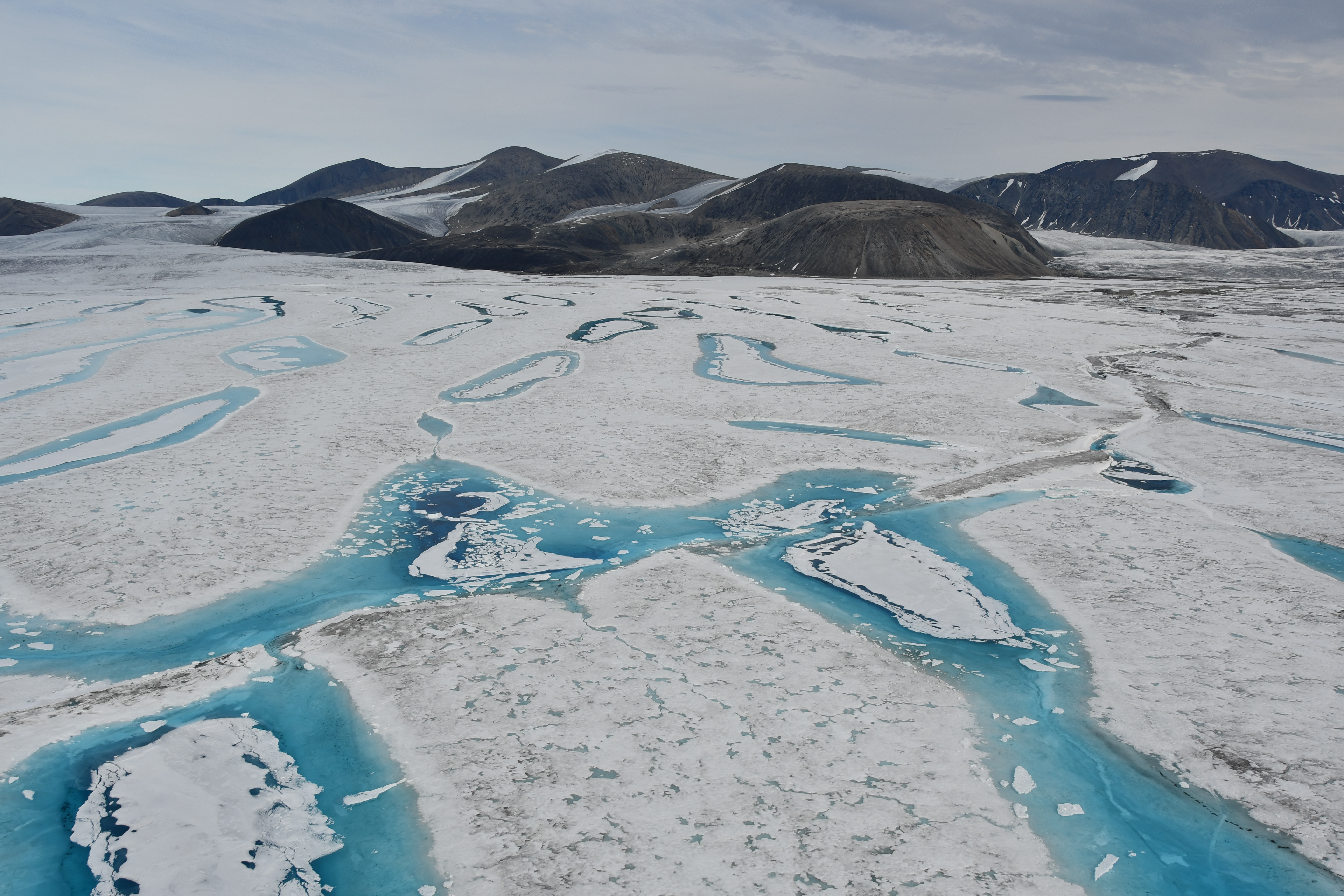
Meltwater lakes form every summer in depressions on the Milne Ice Shelf. Photo: Jérémie Bonneau
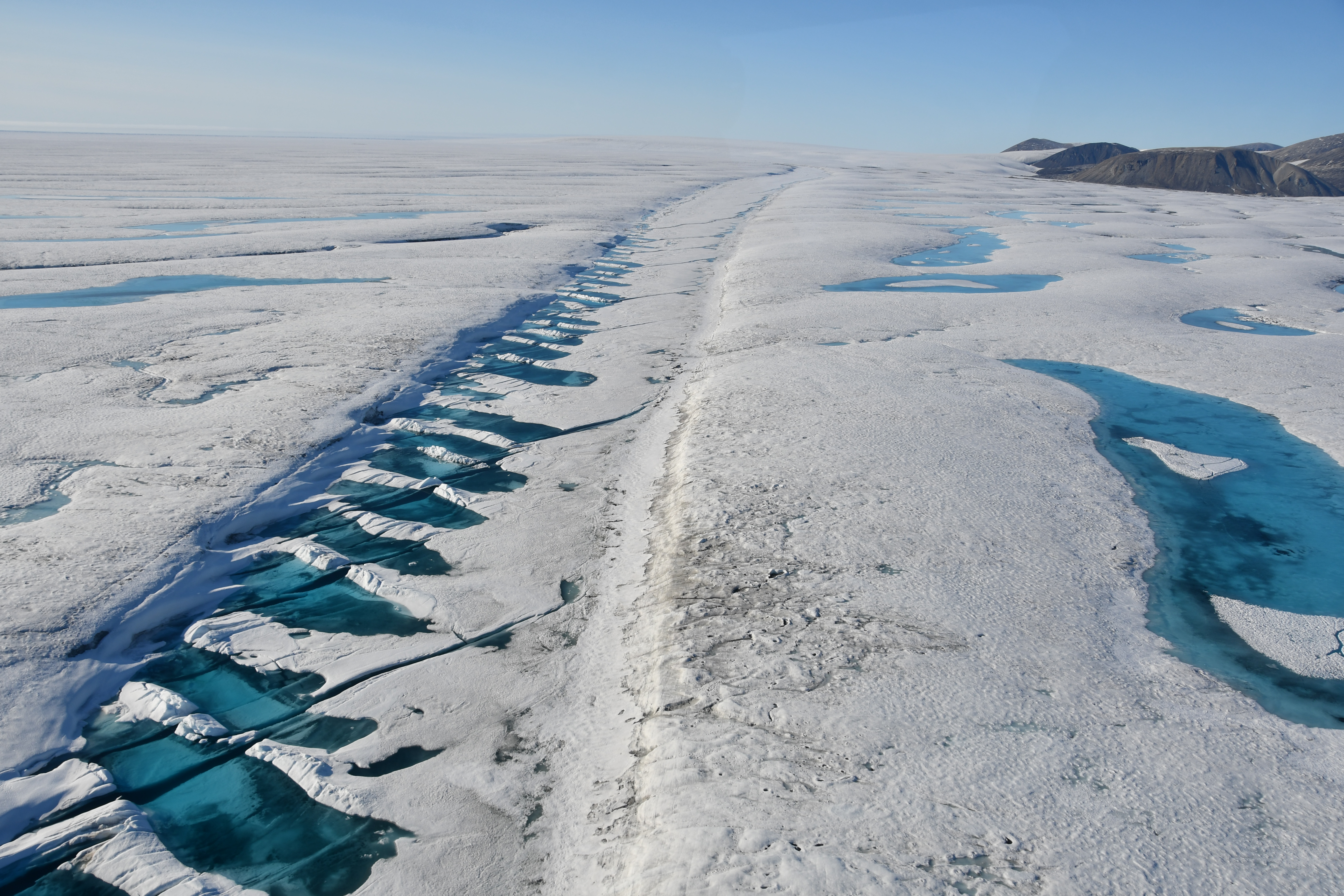
Looking north along a rift in the Milne Ice shelf. This rift is still intact but the ice shelf broke away along a smaller one to the west (left) in July 2020. Photo: Derek Mueller
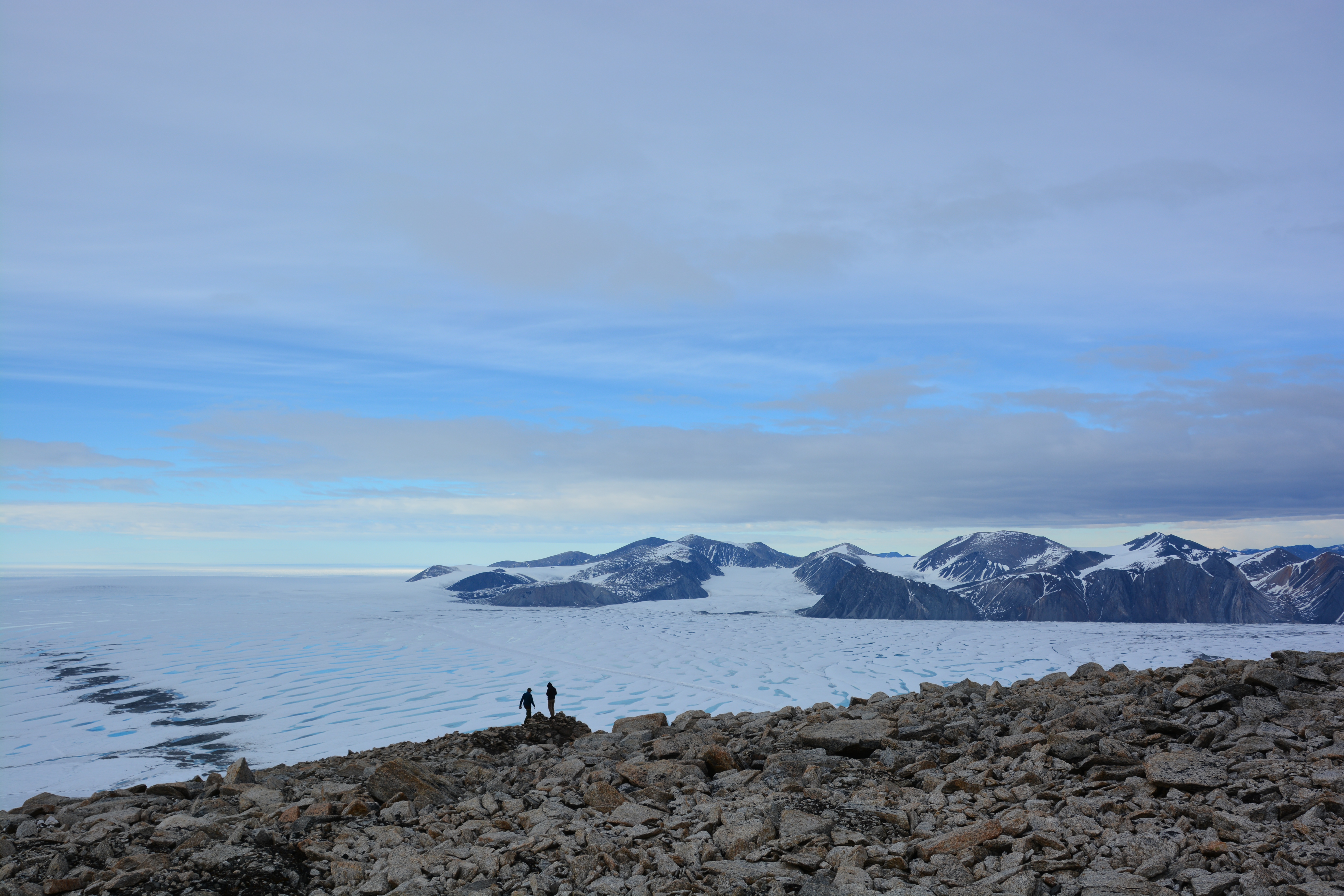
The southern part of Milne Ice Shelf viewed from a ridge along the south-west shore of Milne Fiord. Photo: Jérémie Bonneau
For more images of the Milne Ice Shelf, check out the photo gallery here!
Video (no sound) of flying over the Milne Ice Shelf is available here
BACKGROUND ON CANADA’S ICE SHELVES
Ice shelves are thick floating ice masses attached to the coast. In Antarctica, they mainly form as the seaward extensions of glaciers and ice sheets. In the Canadian Arctic, it is primarily through the in situ accumulation of sea ice over centuries that ice shelves formed. Where fed by glaciers, ice shelves can act as buttresses that slow the flow of ice into the ocean, thus limiting global sea level rise. When ice shelves span the mouth of a fjord, they can become floating dams that trap meltwater runoff behind, creating rare ecosystems known as epishelf lakes. The recent widespread break-up of ice shelves in the Arctic and Antarctic is of concern, as their calving has led to the formation of massive ice islands, which become hazards to maritime operations, the loss of rare epishelf lakes, and has resulted in the acceleration of glaciers into the ocean, increasing the rate of global sea level rise.
In the Canadian Arctic, the northern coast of Ellesmere Island used to be fringed by a single ice shelf of over 8,600 km² at the beginning of the 20th century. This large ice shelf formed up to 5,500 years ago when the climate began to cool after a warmer episode following the last “ice age”. However, the extent of the “Ellesmere Ice Shelf” drastically decreased since then, leaving only 535 km² of ice shelves, mainly around Ward Hunt Island, Milne Fiord and Petersen Fiord. For more information on the past 2 large calving events click here and here. The recent break-up of the Milne represents a reduction of ~80 km² in ice shelf area. The last epishelf lake in the Canadian Arctic is located in Milne Fiord, where Milne Ice Shelf blocks the fresh meltwater from flowing freely out to the ocean. We are unsure if the Milne Fiord epishelf lake still exists, as this depends on the integrity of the remaining part of Milne Ice Shelf.
The recent break-up of the ice shelves of northern Canada has occurred under a warming climate. This region has warmed far more rapidly than the globe and summer air temperatures have record breaking over the past several years.
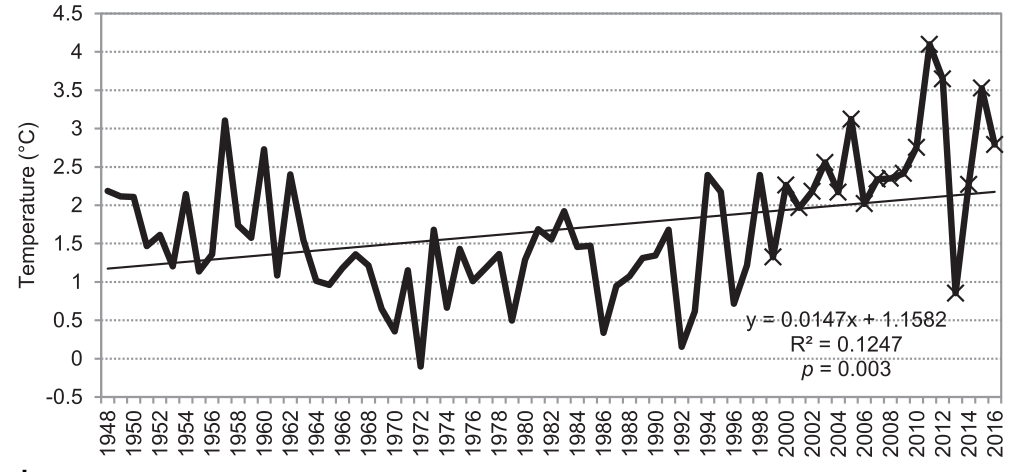
Summer air temperatures in the region have been rising by 0.15 degrees C per decade winter temperatures have been rising even more. (Source: White and Copland 2019)
MILNE ICE SHELF CHANNEL AND BENTHIC ECOSYSTEM
In 2015, we started to explore a surface depression that ran across the Milne Ice Shelf using ice-penetrating radar. Crossing back and forth along this depression we mapped the underside of the ice shelf and found a sub-ice shelf channel where water from the epishelf lake flowed out to the Arctic Ocean. When we melted a small hole through the 10 m thick ice at the top of the channel, we made a startling discovery. Using a remotely operated vehicle (ROV) we found that there was a ‘bench’ of ice right below the ice channel which we never were able to observe in our radar surveys. Much to our wonder, we discovered that the surface of that ice bench contained sediment and many benthic (bottom-dwelling) organisms living right there in the middle of the ice shelf! Researchers have found animals underneath ice shelves before (far from the open ocean and in the complete darkness). However, to our knowledge, nobody has found a community of benthic organisms living within an ice shelf. These communities seem to be fairly well-established and they must get their food from the sediments that drift through the water column from the epishelf lake. Below we have a video of the animals we found in the channel.
The following animals were identified by Philippe Archambault, Cindy Grant, Lisa Treau de Coeli, and Laure de Montety from Université Laval: Brittle stars (Ophiuridae), Worms (Polychaeta), Scallops (Pectinidae), Sponges (Porifera), Anemone (Actiniaria), Sea cucumber (Holothuroidea), Soft coral (Nephtheidae), Hydrozoa, Arctic cod (Boreogadus). We were slated to collect some specimens this summer to determine how old they were and further describe this wonderful ecosystem. However, COVID-19 and the ice shelf break-up have thwarted these plans.
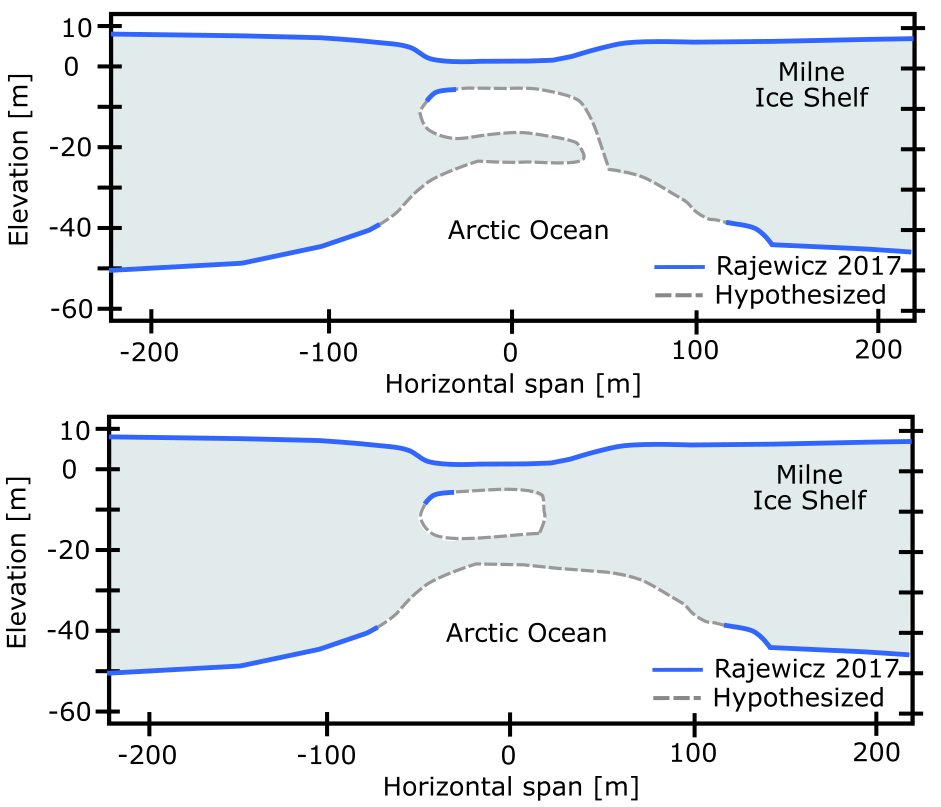
Cross section of the ice shelf channel from Jill Rajewicz’s ice-penetrating radar survey (blue line). In some locations the radar return was not interpretable, however we know there is a horizontal bench of ice within the channel where the benthic animals live from our ROV surveys. We can only guess at the morphology of the channel and think there may be two options – a meandering current caused a bench (top) or a tunnel exists in the the ice where water from the epishelf lake flows (bottom). Diagram courtesy of Drew Friedrichs and Jérémie Bonneau
WIRL’s work on the Milne Ice Shelf is made possible through in-kind support from Polar Shelf, along with financial support from ArcticNet, NSERC, NSTP, and the Canada Foundation for Innovation.
Work on the Milne Ice Shelf is a collaboration between Derek Mueller and:
- Luke Copland, University of Ottawa
- Adrienne White, Canadian Ice Service
- Bernard Laval, University of British Columbia
- Alexander Forrest, University of California, Davis
- Philippe Archambault, Laval University
- Warwick Vincent, Laval University
- Christine Dow, University of Waterloo
- Won Sang Lee, KOPRI
